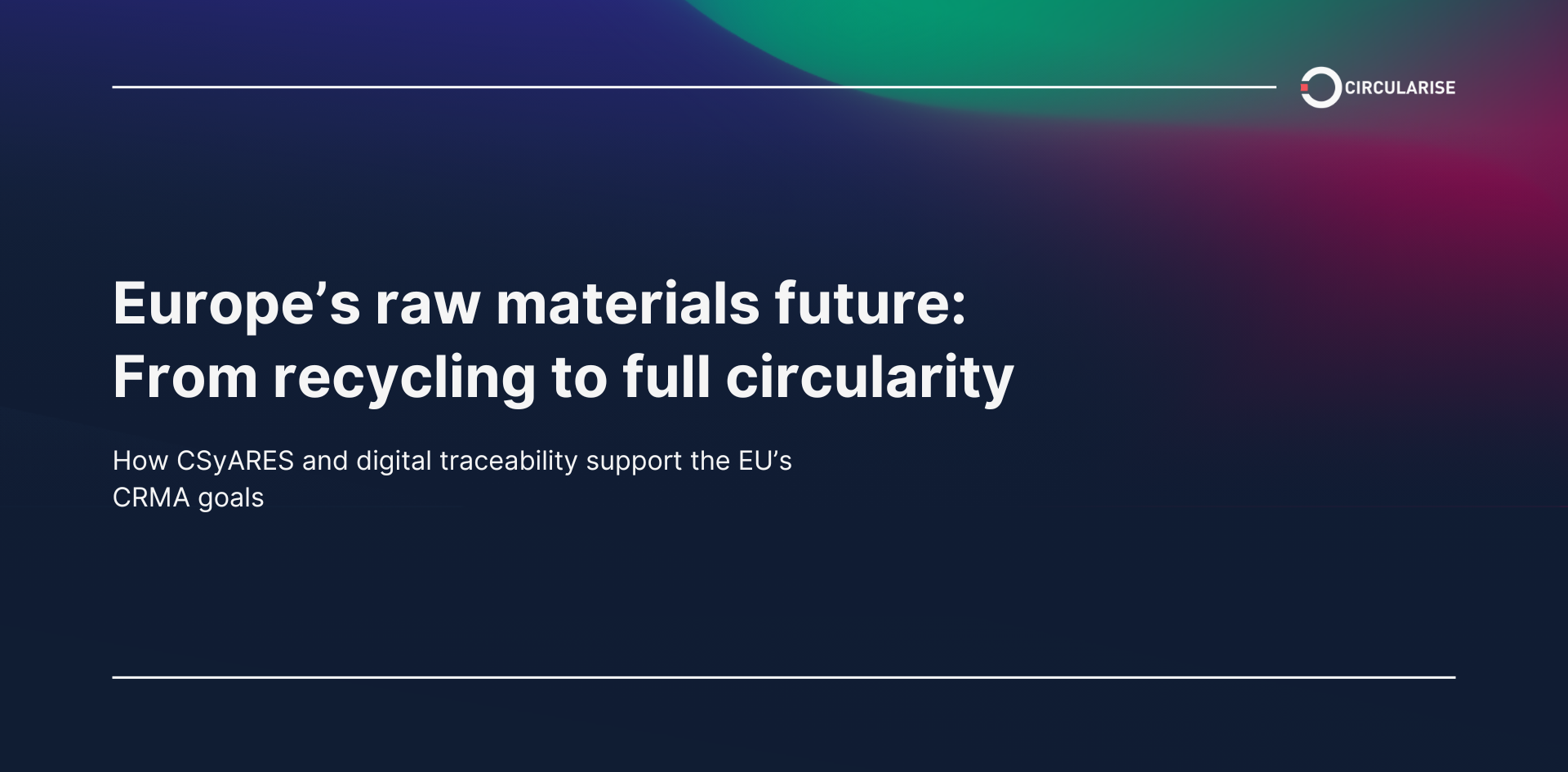Digital product passports are a way to maintain and exchange accurate records along a product’s lifecycle. This would include information on its origins, use, performance, maintenance, disposal, warranty, and sustainability information.
This article defines what information goes into a digital product passport based on new sustainability and supply chain due diligence regulations such as the Ecodesign for Sustainable Products Regulation (ESPR) , the EU Conflict Minerals Regulation, the EU Battery Regulation, the German Supply Chain Act (LkSG), Corporate Sustainability Due Diligence Directive (CS3D) and Corporate Sustainability Reporting Directive (CSRD) just to name a few. Combined with learnings from industry initiatives and pilots Circularise completed focusing on the implementation of digital product passports.
The best way to stay compliant with these regulations and benefit from this trend is to create a plan and outline the steps for setting up a digital product passport.
What information goes into a digital product passport?
The information in a digital product passport allows stakeholders in the value chain to map information and obtain a better understanding of the composition of the product, the environmental impact of the production and use phase, and the recycling solutions at the end of the lifecycle.4
The EU Ecodesign for Sustainable Products Directive (ESPR) makes digital product passports mandatory for all businesses operating on the territory of the EU. Other than outlining what data must be included in a DPP, it also includes deadlines by which DPPs must be finalised and published. By 2026, The European Commission’s digital registry will be able to store unique identifiers of DPPs.
All information requirements for a digital product passport should be relevant and serve a purpose, with every piece of information having a clear scope and concrete user benefit along the product life cycle.2 The ESPR indicates that a digital product passport should contain the following data, as well as any other “voluntary data” on information-sharing procedures that can be digitised and streamlined into the system.
.avif)
- Product Identification: Information on the product's name, model, serial number, and any other identifying characteristics. A unique product identification is necessary for linking the physical product with the product-related information.4
- Materials: All the materials used within the life cycle of the product. This includes the origins of the materials, the availability of critical materials and material flows,
- Product Design: The processes that transform the materials into the technical specification for that product1 and material flows.
- Technical Specifications: Details of the product's performance and technical capabilities including power ratings, dimensions, weight, and other relevant specifications.
- Product Lifecycle: Refers to the consecutive, interlinked stages of a product from raw material use to final disposal1.
- Installation and maintenance: Detailed steps on installation, usage, maintenance, and repair, including third-party software installation where relevant.
- Material composition: Disclose the presence of recycled and renewable materials in the product
- Microplastics: The release of microplastic or nanoplastic during the production, use, or disposal of the product
- Environmental impact: The product’s carbon and material footprints, or any other environmental impact
- Repair and replace: Information on spare parts availability, component compatibility, and modularity, with non-destructive disassembly guidance for repairs and replacements.
- Reuse and Recycling Information: Details on the recyclability of materials, and information on how materials can be reused, remanufactured, or recycled to keep materials in the loop.
- Product Maintenance: Records of product service, repairs, and upgrades performed as well as any relevant maintenance schedules.
- Warranty Information: Details of the product's warranty coverage, including any applicable terms and conditions.
- Energy Recovery: the generation of energy through direct incineration with the recovery of heat through combustible waste1.
- Substances of concern: some text
- Identification: Name, identification code (IUPAC, EC number and CAS number), location of the substance within the product with its concentration levels.
- Usage and handling: Safe usage instructions, disassembly guidance, and handling protocols for substances of concern.
- Lifecycle tracking: Instructions for tracking substances of concern through the product’s lifecycle.
- End-of-life management: Guidelines for disassembly, recycling, and handling hazardous materials, with processes for safe disposal, refurbishment, reuse, and remanufacturing.
Data included in a digital product passport must be kept up-to-date. A product’s DPP has to stay available until the end of the product’s lifecycle. A backup copy should also be made available through a delegated service provider. Companies that want to stay compliant must start collecting the necessary data and share it in an efficient and secure way with the relevant stakeholders all along their supply chain, as well as encourage the improvement of their products and reduce their impact on the environment. However, it is not enough to merely fulfil the basic requirements for digital product passports. If stakeholders work together to provide more voluntary information for digital product passports, they would all benefit from unlocking circular economy opportunities that would add more value to the entire value chain overall. For this to happen, a collaborative innovation approach is necessary for lasting, systemic change in the transition to circularity.

Industry-led initiatives
Neste’s digital product passport pilot for traceability
Neste Corporation is engaging its polymers and chemicals value chain partners to create greater traceability throughout the supply chain when it comes to the use of more sustainable raw materials, such as renewable or recycled feedstock for polymers.
Their goal is to validate what types of traceability data would add value to their customers and partners further down in the value chain. Direct customers need to know about compliance data for renewable or recycled materials, while companies downstream may want more information about greenhouse gas (GHG) emissions or country of origin, for example.
Determining the data scope was a learning process for all partners involved in the digital product passport pilot project, requiring inputs from many different parties and many rounds of feedback and iterations that are still ongoing today. It took time to ensure that all counterparts involved in the pilot had a common understanding of data and terminology and spoke the same language. Standards used across the value chain required comprehensive alignment, such as attributes relating to GHG emissions and carbon footprint.
Because the polymers value chain is very complex and involves multiple processing steps which may lead to the continuous mixing of different material streams, transparency and traceability are crucial for them to be able to substantiate their sustainability claims for their sustainable products. It is particularly valuable to have the guarantee of origin and accurate measurement of environmental impact. With digital product passports, materials can be followed through the value chain to build trust with downstream partners and end consumers on the quality, properties, and content of their products, as well as the reliability of their sourcing claims.
At the same time, transparency also means giving away information and sharing it with other companies in the value chain - something that is also subject to concern if sensitive information is involved. That’s why one learning from the pilot project is that the right balance between private and public data has to be found. What can or cannot be shared in the public chain is therefore one of the crucial questions to be considered. This makes selective data sharing an important feature, as it also provides flexibility for changes later in the process.
Other than Neste, other forward-thinking organisations and work groups are driving digital product passports and building on existing frameworks and regulations.
What to look out for with digital product passports

Today, product information relevant to digital product passports is already being supplied in a variety of formats, provided mainly by manufacturers and suppliers. Yet supply chain visibility remains one of the largest obstacles companies face in implementing circular practices. Collaboration between all stakeholders in the supply chain is a key step in facilitating the information transfer required to make circularity scalable and profitable. There is no one-size-fits-all approach.
The information in digital product passports would be relevant to different user groups with different levels of detail. Therefore it is important for each member of the value chain to be able to determine what data they need or want. Having a secure and robust online database or system with varying levels of access and privacy is essential to handling confidential information for different groups.
A decentralised approach to information storage makes the data tamper-proof and reliable, and works best for scalability and interoperability, increasing the ease of information sharing. Ideally, data flows can be automated as managing multidirectional information flows will be necessary. Therefore it is important to ensure that the systems are not too complicated and difficult to use.
Other issues to address include data privacy and protection for all stakeholders in the value chain, as well as responsibility of the data originators – how can they provide all the information required by the value chain, reduce inaccuracies, and discourage dishonest practices that undermine the entire system.
Where to start with digital product passports (DPPs)
Companies looking to implement digital product passports can start by:
- Identify the information to be shared
- Align with the other value chain members that need to be involved
- Build the business case for the ROI of digital product passports
- Test it out with preliminary pilots
- Learn and scale these efforts
It's important to identify clearly defined products and sectors to run pilots “based on a phased approach with the possibility for continuous extension and further development”.2 It is possible to start modestly with some basic information about the product composition, and slowly increase the scope and granularity of the data based on the learnings. But it will take time and a real commitment from all parties involved.
Providing detailed information about products in the digital product passport allows manufacturers and retailers to share relevant information with customers, auditors, and regulators. Companies are able to provide proof to back up sustainability claims about their sustainable products and services. It can also help companies track and improve their products over time, allowing them to better serve the needs of their customers and meet sustainability requirements. But providing more voluntary information beyond the basic requirements will be the key to unlocking profitable circular economy business models that would increase value for all stakeholders in the supply chain. This could be a big step forward for sustainability and usher in a new era of circularity based on digital data sharing.

Circularise is the leading software platform that provides end-to-end traceability for complex industrial supply chains. We offer two traceability solutions: MassBalancer to automate mass balance bookkeeping and Digital Product Passports for end-to-end batch traceability.







